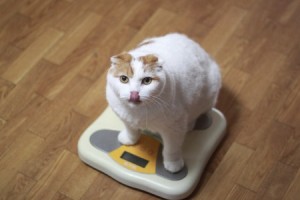 Oct 12 is Pet Obesity Awareness Day. Why do we need a special day to bring awareness about our pets’ weight? Because according to the Association for Pet Obesity Prevention, an estimated 58% of cats and 54% of dogs in the U.S are overweight. And your chubby friend isn’t just having a little more trouble getting around these days, there are many other serious, even life-threatening, side-effects for your overweight pet. And the hard thing to realize is that you are the reason for your dog or cat’s obesity—and you are the only one who can help get him or her back to their svelte self.
Oct 12 is Pet Obesity Awareness Day. Why do we need a special day to bring awareness about our pets’ weight? Because according to the Association for Pet Obesity Prevention, an estimated 58% of cats and 54% of dogs in the U.S are overweight. And your chubby friend isn’t just having a little more trouble getting around these days, there are many other serious, even life-threatening, side-effects for your overweight pet. And the hard thing to realize is that you are the reason for your dog or cat’s obesity—and you are the only one who can help get him or her back to their svelte self.
What’s Causing the Pet Obesity Epidemic?
Well, that’s not hard to figure out. It’s the same cause as the obesity epidemic in the human population—too much food, too little exercise. But your pet can put the blame squarely on your shoulders. You are the one who provides the food and exercise.
You love your cat or dog, but sometimes you love them in unhealthy ways. Often you can’t resist giving one more treat to show your affection, or you don’t pay attention to the feeding guidelines for your pet’s food, or you get in the habit of adding table scraps to his or her food because you feel sorry that they have to eat the same kibble or pouch food every day. But your kindness could be killing them.
What Are the Consequences of Pet Obesity?
Even a few extra pounds can be harmful for your pet’s health. An overweight dog or cat is at greater risk for high blood pressure, respiratory problems, kidney disease and heart disease. They are at a much greater risk of developing diabetes as well as certain types of cancer. The extra weight is hard on your animal’s joints, which is painful and can lead to arthritis and other bone and joint conditions. These are not conditions you should take lightly—if you want to have more healthy years with your furry friend.
How Do You Know Your Pet Is Overweight?
It’s a sad statistic that more than 50% of U.S. pets are overweight, but it’s even sadder that, according to the American Veterinary Medical Association, only 17% of owners believe their pet is fat.
If you take your pet for regular visits to your veterinarian, he can let you know if your friend is at a healthy weight. But there are some things you can look at yourself. When you view your pet from the side, his or her abdomen behind the rib cage, should be tucked up. When you look from above, you should see a clear waistline, and when you feel your pet’s body, you should be able to feel the ribs, spine and hip bones.
Also, you can use general guidelines for what your animal should weigh. For example, a golden retriever should weigh 65-75 pounds, a beagle should weigh 18-30 pounds and a Yorkie less than 7 pounds. VCA Animals provides a list of what most dog breeds should weigh. You can use it as a guideline for what your dog should weigh. Most cat breeds should weigh less than 10 pounds, except for the Maine Coon, which can get up to 25 pounds.
What Can You Do to Get Your Friend Back on Track?
It’s not rocket science: less food, fewer treats, and more exercise. However, you should first consult with your veterinarian to rule out any medical cause, especially if the weight gain was sudden. Then talk to him about a safe diet plan that will help with weight loss. Just as with humans, weight loss should be gradual. Here are a few other things you can do on your own:
- Feed a high-quality, low-fat, low-carb pet food and feed according to the directions.
- Avoid high-fat, high calorie treats. Try sweet potatoes, green beans, bananas and baby carrots, or tiny training treats.
- No more table scraps, you’re just adding calories.
- Get up off the couch. An overweight animal tends to be more sedentary, which exacerbates the weight problem. Regular walks will do you both good. Don’t do a 5K immediately—just take baby steps at first. Use laser lights or feather toys to encourage activity for your cat.
- Keep a record of your pet’s weight to monitor progress.
The Association for Pet Obesity Prevention has a set of tools, such as calorie counters, exercise tips and daily food and exercise logs you can use to help your cat or dog shed the pounds.
Obesity is one of the most serious health problems your pet faces, but it’s also one of the most preventable. The good news is you don’t have to do it alone. Enlist the help of your veterinarian. He can suggest a proper diet for your cat or dog’s situation and recommend how fast they should lose the extra pounds. Plus, your veterinarian’s office has a scale that he typically won’t mind you using to monitor your pet’s weight loss progress. If you think your furry friend is getting a bit pudgy, give Powell Veterinary Service a call at 970-352-9164, and we can set up an appointment for an evaluation and subsequent diet plan.

WORKING HOURS:
Monday-Friday 8:00am - 5:00pm
Saturday 8:00am - 12:00 noon